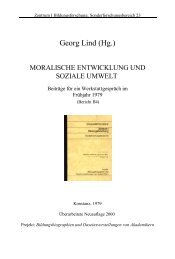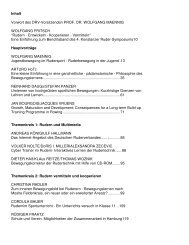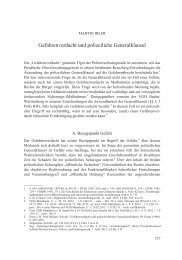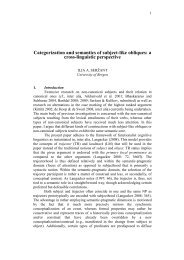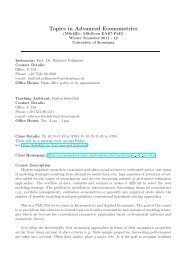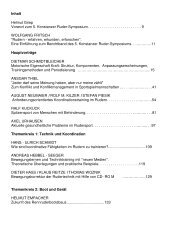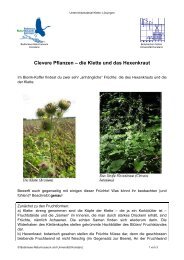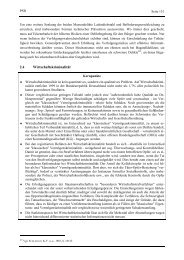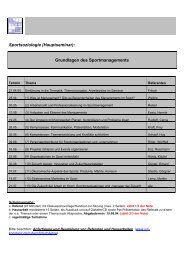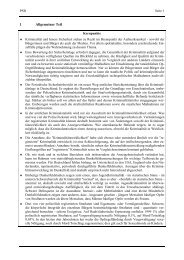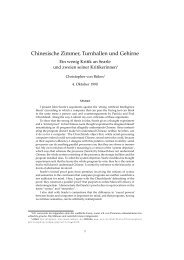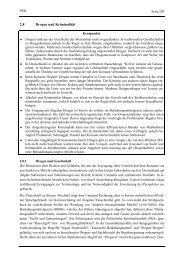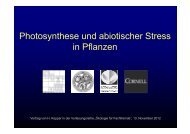Book of Abstracts Book of Abstracts - Universität Konstanz
Book of Abstracts Book of Abstracts - Universität Konstanz
Book of Abstracts Book of Abstracts - Universität Konstanz
You also want an ePaper? Increase the reach of your titles
YUMPU automatically turns print PDFs into web optimized ePapers that Google loves.
A - 36<br />
The Size-Evolution <strong>of</strong> the Optical Properties <strong>of</strong> Supported Gold<br />
Clusters and Nanocrystals Studied by Cavity Ringdown Spectroscopy:<br />
From the Atom to the Bulk<br />
154<br />
J. M. Antonietti, M. Michalski, H. Jones, and U. Heiz<br />
Institute <strong>of</strong> Surface Chemistry and Catalysis, <strong>Universität</strong> Ulm, 89069 Ulm, Germany<br />
Measuring the size-dependent electronic structure <strong>of</strong> supported clusters near the Fermi level<br />
is <strong>of</strong> critical importance in order to understand the catalytic activities <strong>of</strong> supported clusters or to<br />
tune the optical properties <strong>of</strong> cluster assembled materials with the number <strong>of</strong> atoms. Up to now,<br />
extensive studies on the electronic structure <strong>of</strong> size-selected, supported clusters are sparse,<br />
because <strong>of</strong> the experimental challenges which must be overcome: preparation <strong>of</strong> monodispersed<br />
samples, high sensitivity required for recording the signal arising from a highly dilute sample,<br />
detection <strong>of</strong> the signal due to the clusters from the intense background signal arising from the<br />
substrate.<br />
In order to overcome these problems, a new experimental setup has been designed and built to<br />
perfom Cavity Ringdown Spectroscopy (CRDS) in the visible spectral range on size-selected<br />
clusters deposited on silica in UHV conditions. The clusters are produced in a laser vaporization<br />
source, size-selected in the gas phase, and s<strong>of</strong>t-landed onto the substrate.<br />
In this work, the ability to prepare monodispersed cluster samples is demonstrated. The ultimate<br />
sensitivity <strong>of</strong> the setup is such that absorption cross-sections <strong>of</strong> 0.02 Å 2 with cluster coverage<br />
down to 0.05% <strong>of</strong> a monolayer (~1 10 12 clusters/cm 2 ) can be detected. The absorption spectra <strong>of</strong><br />
gold clusters, Aun (n = 1, 4, 8, and 20) deposited on silica are presented. Additionally, the<br />
optical properties <strong>of</strong> self-organized gold nanocrystals with well-defined diameters (1 to 20 nm),<br />
prepared by chemical means and deposited on silica have been measured. The spectrum <strong>of</strong> the<br />
atom exhibits sharp peaks which are attributed to atoms attached at various defect sites on the<br />
surface. A dramatic size-sensitivity <strong>of</strong> the absorption properties <strong>of</strong> clusters is observed.<br />
However, Au8 shows features which are associated with nanocrystals, rather than small clusters.



